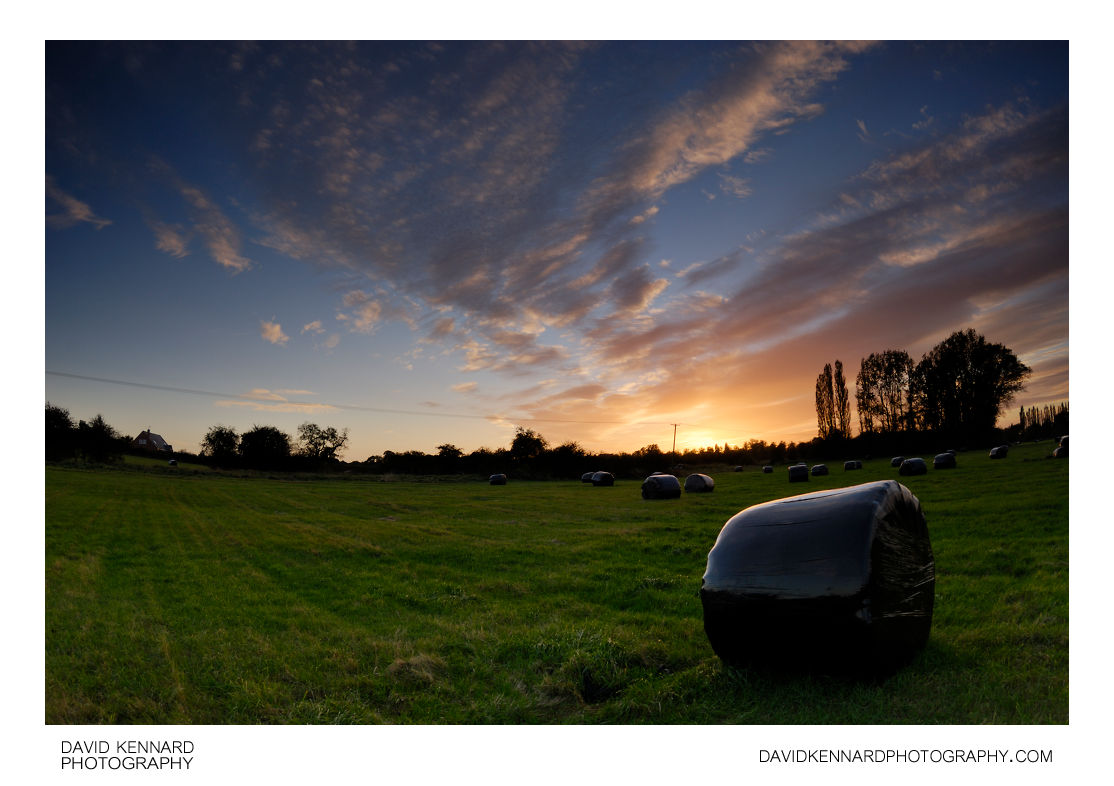Sunset over hay field between Lubenham and Harborough

Description
- Title:
- Sunset over hay field between Lubenham and Harborough
- Caption / Description:
-
The sun sets over a hay field between Lubenham and Market Harborough, in Leicestershire, England. In the foreground sits a black plastic wrapped silage bale.
Silage is fermented, high-moisture fodder that can be fed to cud-chewing animals like cattle and sheep. It is fermented and stored in a process called ensiling or silaging, and is usually made from grass crops, using the entire green plant (not just the grain).
For baled silage the grass is cut and partly dried until it contains 30–40% moisture (much drier than bulk silage, but too damp to be stored as dry hay). It is then made into large bales which are wrapped tightly in plastic to exclude air. The plastic may wrap the whole of each cylindrical or cuboid bale, or be wrapped around only the curved sides of a cylindrical bale, leaving the ends uncovered.
Description adapted from Wikipedia: http://en.wikipedia.org/wiki/Silage
- Tags / Keywords:
-
- Europe
- UK
- Britain
- England
- East Midlands
- Leicestershire
- Field
- Market Harborough
- Countryside
- Sunset
- Rural
- Lubenham
- Black Plastic Wrapped Haybales
- Silage bale
Admin
- Date Original Photo Taken:
- Original File Name:
- _DSC1753-5.psd
- Event:
- Rating:
- ☆
- Date this image added/last updated on website:
- Original File Dimensions:
- 3872px x 2592px
- File Type:
- JPEG
- Color Mode:
- RGB
- Original Image Color Profile:
- Nikon Adobe RGB 4.0.0.3000
Location
- Location Shown:
-
- Sublocation:
- City:
- Lubenham
- Province/State:
- Leicestershire
- Country:
- United Kingdom
- World Region:
- Europe
- Location Created:
-
- Sublocation:
- City:
- Lubenham
- Province/State:
- Leicestershire
- Country:
- United Kingdom
- World Region:
- Europe
- Geo-location:
- 52.475604588944, -0.95138632999722 View on map
Rights
- Copyright Status:
- Copyrighted
- Licensing Status:
- Rights Managed
- Available for Editorial Use:
- Yes
- Available for Commercial Use:
- No
- Copyright Notice:
- © 2010 Dave Kennard
Camera Data
- Date Digital Resource was created:
- Shutter speed:
- 1⁄8 s
- Aperture:
- f/8
- Camera Model:
- Nikon D200
- ISO:
- 100
- Exposure Compensation:
- +1
- Focal Length:
- 14mm
- Focal Length (35mm equiv.):
- 21mm
- Metering Mode:
- Multi-segment
- Flash:
- No Flash
- Exposure Mode:
- Manual
- White Balance:
- Manual
- Light Source:
- Cloudy
- Exposure Program:
- Manual
Additional shooting metadata
- Lens:
- Tokina ATX107 DX FishEye 10-17mm F3.5-4.5
- Filters used:
-
- Hitech 85 Neutral Density Split Grad Hard Edge ND 0.9
- Additional Optics used:
- Setup:
- Benro C-428 Tripod
Markins M10 Ball head
Shutter release cable
Bracketed ±1EV
Post Processing
- Image Modified:
- Software used:
-
- Nikon Capture NX 2
- Adobe Photoshop CS5
- Post Processing:
NEFs converted with -0.3 exposure compensation in CNX2
Images blended for exposure in PS CS5
LCE selectively applied in PS CS5
